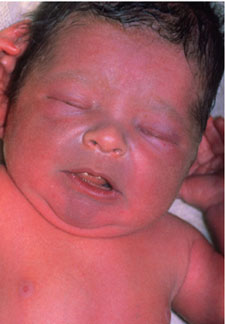
Blue Baby Syndrome: A Comprehensive Guide
Introduction
Blue baby syndrome, also known as cyanotic congenital heart disease (CCHD), is a group of heart defects that result in insufficient oxygenated blood being pumped to the body. This condition is characterized by a bluish tint to the skin, lips, and nail beds, a symptom that arises due to the presence of deoxygenated hemoglobin in the blood. Blue baby syndrome is a serious medical condition that requires prompt diagnosis and treatment to prevent life-threatening complications.
Causes
Blue baby syndrome is caused by structural abnormalities in the heart and blood vessels that impede the proper flow of oxygenated blood to the body. These abnormalities can occur during fetal development and may involve:
- Ventricular septal defect (VSD): A hole in the wall separating the two ventricles (lower chambers) of the heart, allowing oxygenated and deoxygenated blood to mix.
- Atrial septal defect (ASD): A hole in the wall separating the two atria (upper chambers) of the heart, allowing oxygenated and deoxygenated blood to mix.
- Tetralogy of Fallot: A combination of four heart defects, including VSD, pulmonary stenosis (narrowing of the pulmonary valve), overriding aorta (aorta positioned over both ventricles), and right ventricular hypertrophy (enlargement of the right ventricle).
- Transposition of the great arteries: A condition where the aorta and pulmonary artery are switched, causing oxygenated blood to be pumped to the lungs and deoxygenated blood to be pumped to the body.
- Tricuspid atresia: A condition where the tricuspid valve, which separates the right atrium from the right ventricle, is absent or malformed, preventing blood flow from the atrium to the ventricle.
Symptoms
The primary symptom of blue baby syndrome is cyanosis, a bluish tint to the skin, lips, and nail beds. Other symptoms may include:
- Shortness of breath
- Rapid heart rate
- Fatigue
- Poor feeding
- Failure to thrive
- Clubbing of fingers and toes (enlargement and curvature of the tips)
Diagnosis
Blue baby syndrome is typically diagnosed based on a physical examination and a review of the child’s medical history. The doctor may listen to the heart for abnormal sounds, such as murmurs, and check for signs of cyanosis. Additional tests may be ordered to confirm the diagnosis and determine the severity of the condition, including:
- Chest X-ray: To visualize the heart and lungs
- Echocardiogram: An ultrasound of the heart to assess its structure and function
- Cardiac catheterization: A procedure where a thin tube is inserted into the heart to measure blood pressure and oxygen levels
- Electrocardiogram (ECG): To record the heart’s electrical activity
Treatment
The treatment for blue baby syndrome depends on the specific heart defect and its severity. Treatment options may include:
- Medications: To improve heart function and reduce symptoms
- Surgery: To repair or replace the affected heart structures
- Cardiac catheterization: To perform minimally invasive procedures, such as balloon angioplasty or stent placement
- Heart transplant: In severe cases, a heart transplant may be necessary
Prognosis
The prognosis for blue baby syndrome varies depending on the type and severity of the heart defect. With early diagnosis and appropriate treatment, many children with blue baby syndrome can live full and active lives. However, some children may experience ongoing health issues or require additional surgeries throughout their lives.
Complications
Untreated blue baby syndrome can lead to serious complications, including:
- Heart failure: When the heart is unable to pump enough blood to meet the body’s needs
- Stroke: A blockage of blood flow to the brain
- Pulmonary hypertension: High blood pressure in the lungs
- Eisenmenger syndrome: A condition where the pulmonary artery becomes permanently narrowed, leading to irreversible lung damage
- Death: In severe cases, blue baby syndrome can be fatal
Prevention
Blue baby syndrome is not preventable, but early detection and treatment can improve the prognosis. Pregnant women should receive regular prenatal care to monitor the baby’s heart development. If a heart defect is suspected, the doctor may recommend additional testing, such as an echocardiogram.
Conclusion
Blue baby syndrome is a serious medical condition that requires prompt diagnosis and treatment. With advances in medical technology and surgical techniques, many children with blue baby syndrome can live full and active lives. Early detection and appropriate management are crucial to prevent life-threatening complications and ensure the best possible outcome for affected children.
